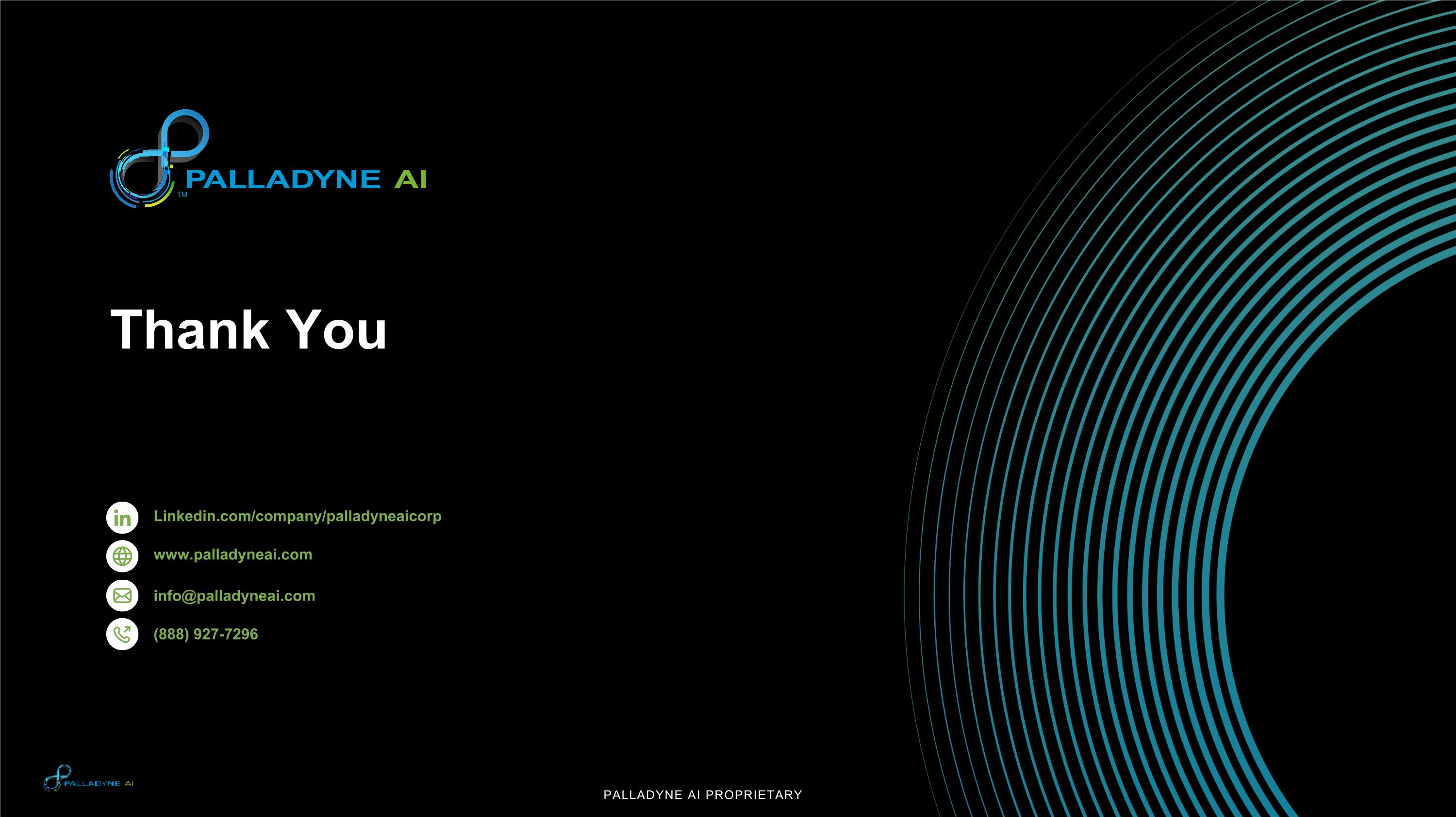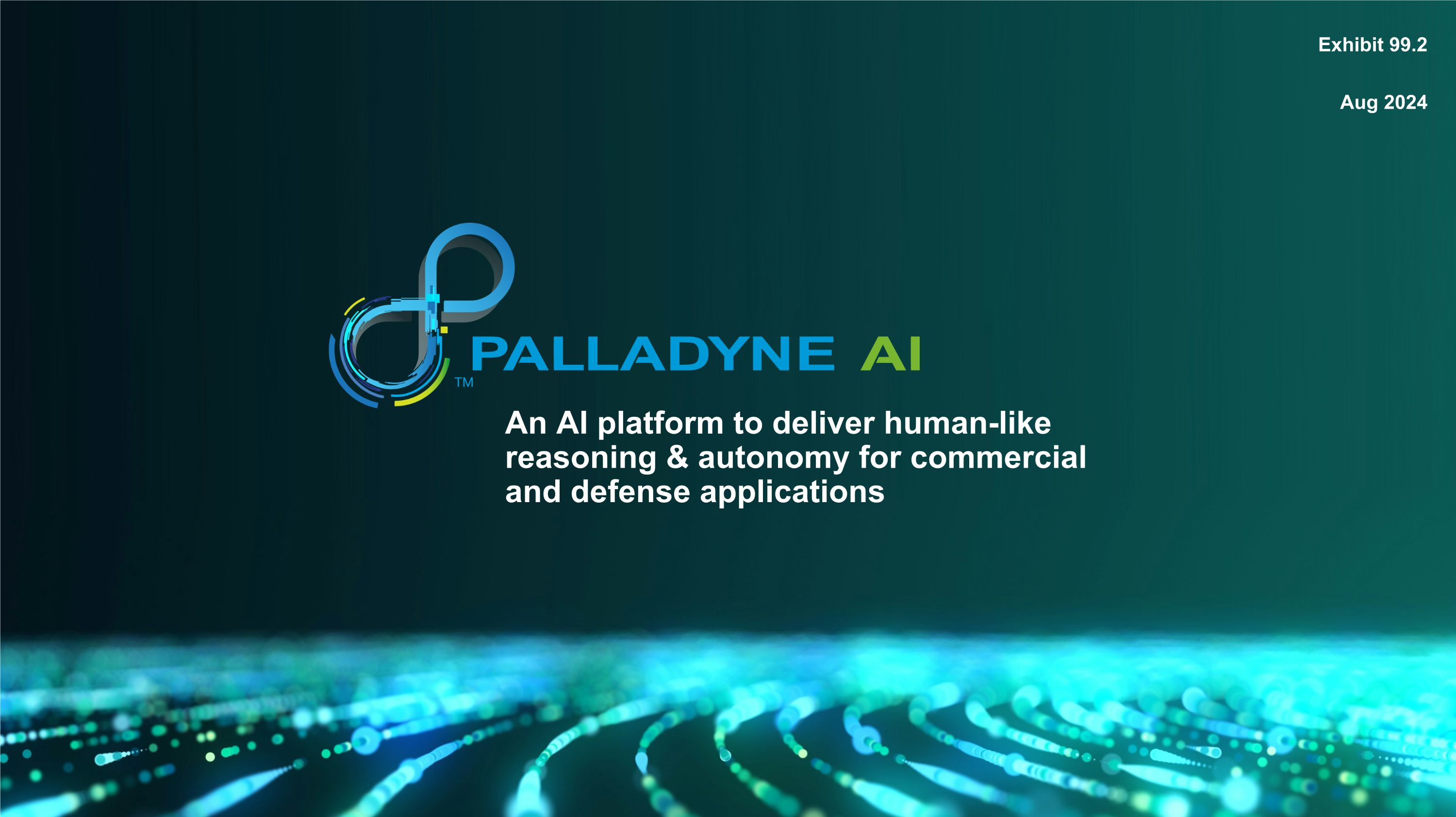
An AI platform to deliver human-like reasoning & autonomy for commercial and defense applications Exhibit 99.2 Aug 2024
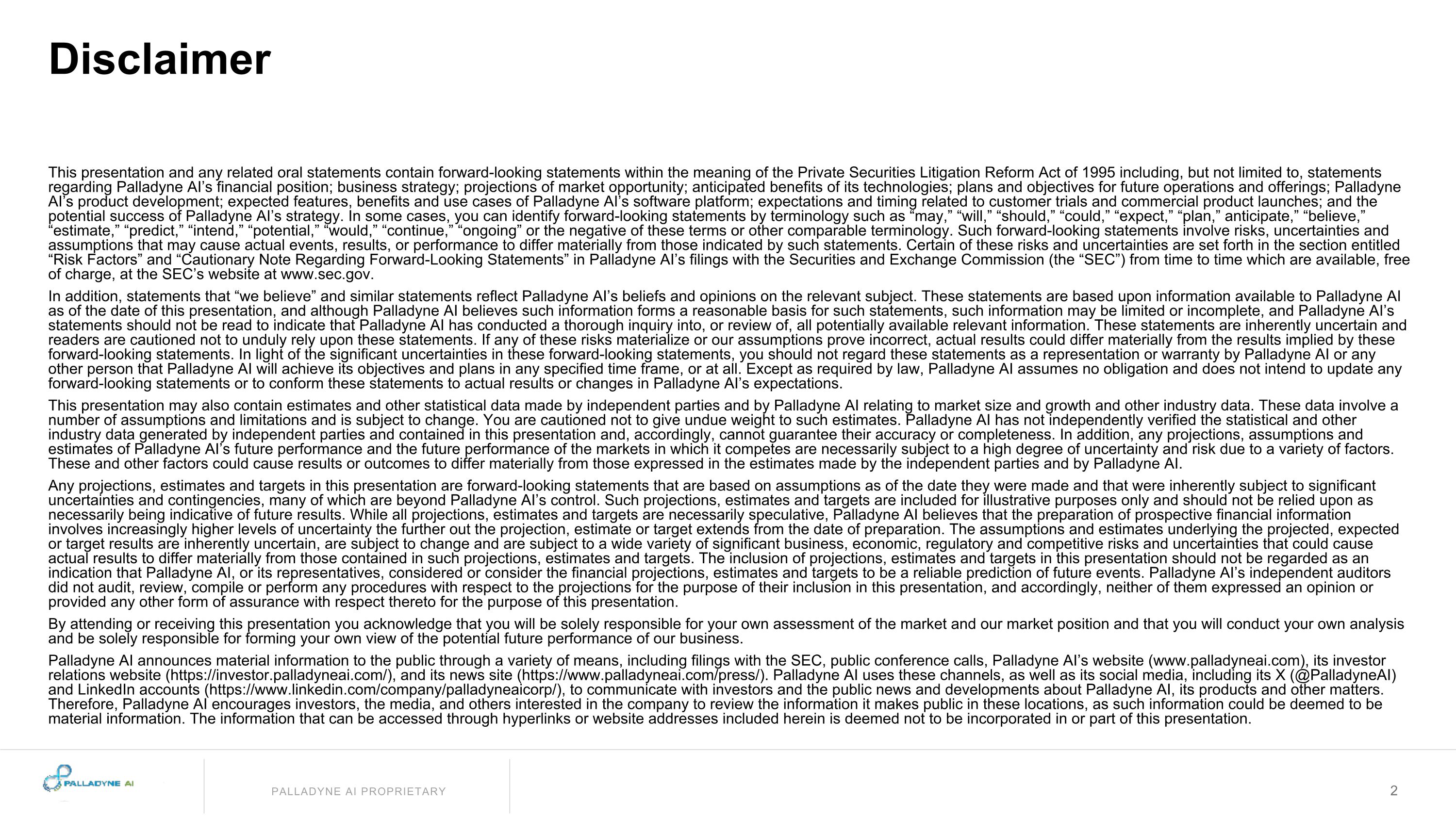
Disclaimer This presentation and any related oral statements contain forward-looking statements within the meaning of the Private Securities Litigation Reform Act of 1995 including, but not limited to, statements regarding Palladyne AI’s financial position; business strategy; projections of market opportunity; anticipated benefits of its technologies; plans and objectives for future operations and offerings; Palladyne AI’s product development; expected features, benefits and use cases of Palladyne AI’s software platform; expectations and timing related to customer trials and commercial product launches; and the potential success of Palladyne AI’s strategy. In some cases, you can identify forward-looking statements by terminology such as “may,” “will,” “should,” “could,” “expect,” “plan,” anticipate,” “believe,” “estimate,” “predict,” “intend,” “potential,” “would,” “continue,” “ongoing” or the negative of these terms or other comparable terminology. Such forward-looking statements involve risks, uncertainties and assumptions that may cause actual events, results, or performance to differ materially from those indicated by such statements. Certain of these risks and uncertainties are set forth in the section entitled “Risk Factors” and “Cautionary Note Regarding Forward-Looking Statements” in Palladyne AI’s filings with the Securities and Exchange Commission (the “SEC”) from time to time which are available, free of charge, at the SEC’s website at www.sec.gov. In addition, statements that “we believe” and similar statements reflect Palladyne AI’s beliefs and opinions on the relevant subject. These statements are based upon information available to Palladyne AI as of the date of this presentation, and although Palladyne AI believes such information forms a reasonable basis for such statements, such information may be limited or incomplete, and Palladyne AI’s statements should not be read to indicate that Palladyne AI has conducted a thorough inquiry into, or review of, all potentially available relevant information. These statements are inherently uncertain and readers are cautioned not to unduly rely upon these statements. If any of these risks materialize or our assumptions prove incorrect, actual results could differ materially from the results implied by these forward-looking statements. In light of the significant uncertainties in these forward-looking statements, you should not regard these statements as a representation or warranty by Palladyne AI or any other person that Palladyne AI will achieve its objectives and plans in any specified time frame, or at all. Except as required by law, Palladyne AI assumes no obligation and does not intend to update any forward-looking statements or to conform these statements to actual results or changes in Palladyne AI’s expectations. This presentation may also contain estimates and other statistical data made by independent parties and by Palladyne AI relating to market size and growth and other industry data. These data involve a number of assumptions and limitations and is subject to change. You are cautioned not to give undue weight to such estimates. Palladyne AI has not independently verified the statistical and other industry data generated by independent parties and contained in this presentation and, accordingly, cannot guarantee their accuracy or completeness. In addition, any projections, assumptions and estimates of Palladyne AI’s future performance and the future performance of the markets in which it competes are necessarily subject to a high degree of uncertainty and risk due to a variety of factors. These and other factors could cause results or outcomes to differ materially from those expressed in the estimates made by the independent parties and by Palladyne AI. Any projections, estimates and targets in this presentation are forward-looking statements that are based on assumptions as of the date they were made and that were inherently subject to significant uncertainties and contingencies, many of which are beyond Palladyne AI’s control. Such projections, estimates and targets are included for illustrative purposes only and should not be relied upon as necessarily being indicative of future results. While all projections, estimates and targets are necessarily speculative, Palladyne AI believes that the preparation of prospective financial information involves increasingly higher levels of uncertainty the further out the projection, estimate or target extends from the date of preparation. The assumptions and estimates underlying the projected, expected or target results are inherently uncertain, are subject to change and are subject to a wide variety of significant business, economic, regulatory and competitive risks and uncertainties that could cause actual results to differ materially from those contained in such projections, estimates and targets. The inclusion of projections, estimates and targets in this presentation should not be regarded as an indication that Palladyne AI, or its representatives, considered or consider the financial projections, estimates and targets to be a reliable prediction of future events. Palladyne AI’s independent auditors did not audit, review, compile or perform any procedures with respect to the projections for the purpose of their inclusion in this presentation, and accordingly, neither of them expressed an opinion or provided any other form of assurance with respect thereto for the purpose of this presentation. By attending or receiving this presentation you acknowledge that you will be solely responsible for your own assessment of the market and our market position and that you will conduct your own analysis and be solely responsible for forming your own view of the potential future performance of our business. Palladyne AI announces material information to the public through a variety of means, including filings with the SEC, public conference calls, Palladyne AI’s website (www.palladyneai.com), its investor relations website (https://investor.palladyneai.com/), and its news site (https://www.palladyneai.com/press/). Palladyne AI uses these channels, as well as its social media, including its X (@PalladyneAI) and LinkedIn accounts (https://www.linkedin.com/company/palladyneaicorp/), to communicate with investors and the public news and developments about Palladyne AI, its products and other matters. Therefore, Palladyne AI encourages investors, the media, and others interested in the company to review the information it makes public in these locations, as such information could be deemed to be material information. The information that can be accessed through hyperlinks or website addresses included herein is deemed not to be incorporated in or part of this presentation.
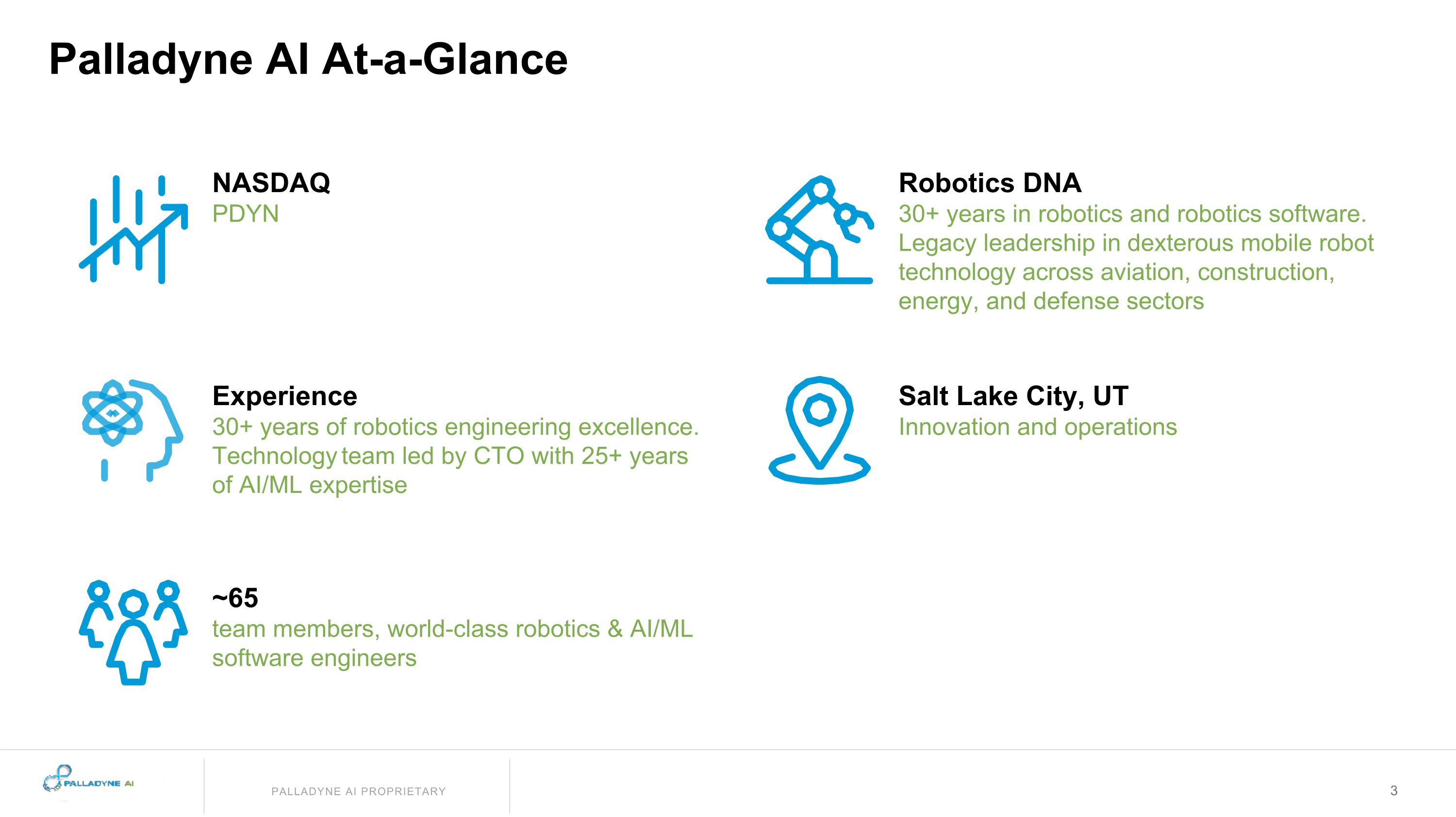
Palladyne AI At-a-Glance NASDAQ PDYN Experience 30+ years of robotics engineering excellence. Technology team led by CTO with 25+ years of AI/ML expertise ~65 team members, world-class robotics & AI/ML software engineers Salt Lake City, UT Innovation and operations Robotics DNA 30+ years in robotics and robotics software. Legacy leadership in dexterous mobile robot technology across aviation, construction, energy, and defense sectors
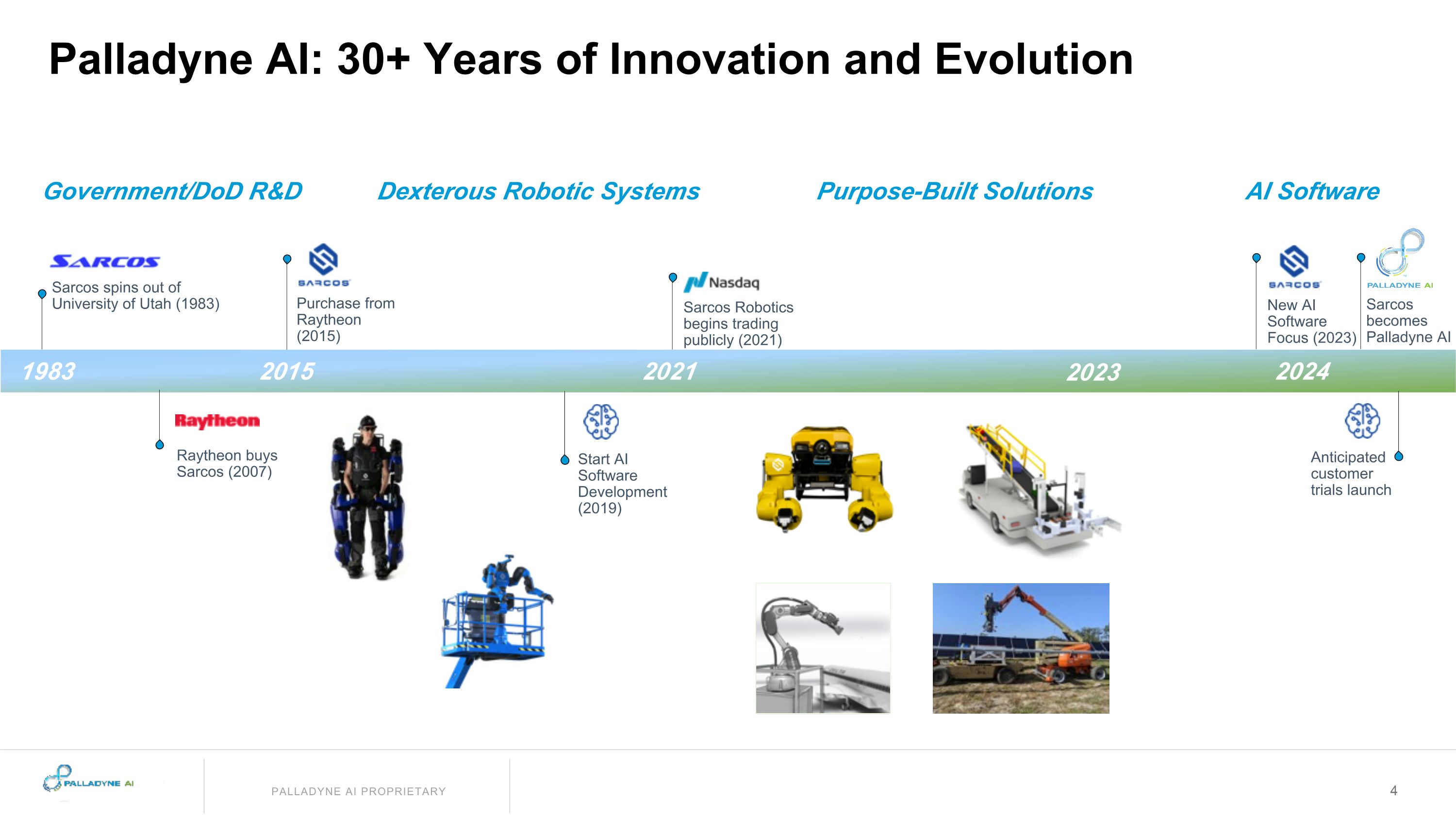
Palladyne AI: 30+ Years of Innovation and Evolution Sarcos Robotics begins trading publicly (2021) Purchase from Raytheon (2015) 1983 2015 2021 2024 New AI Software Focus (2023) Anticipated customer trials launch Government/DoD R&D Sarcos spins out of University of Utah (1983) Dexterous Robotic Systems Purpose-Built Solutions AI Software 2023 Start AI Software Development (2019) Raytheon buys Sarcos (2007) Sarcos becomes Palladyne AI
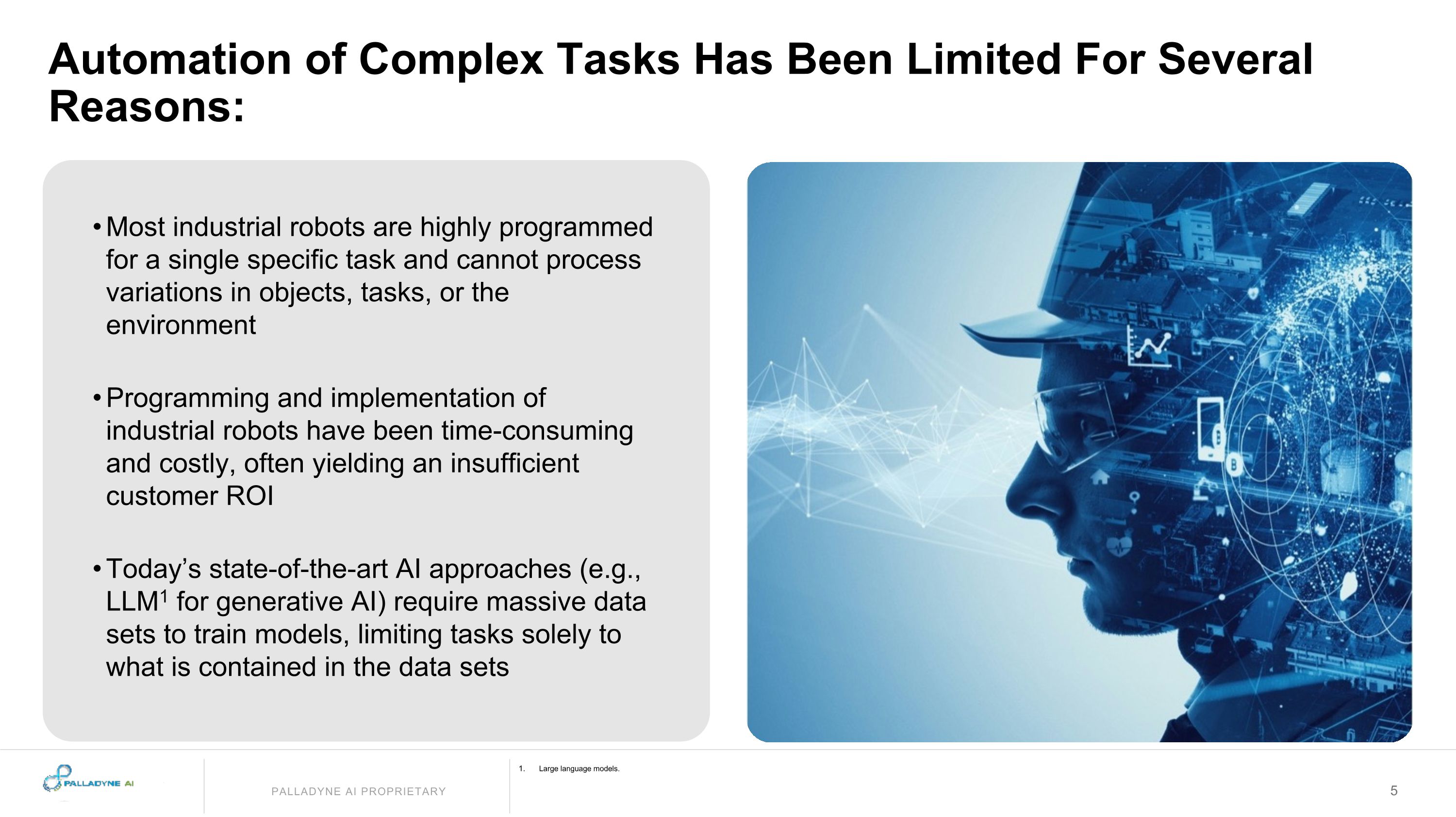
Automation of Complex Tasks Has Been Limited For Several Reasons: Large language models. Most industrial robots are highly programmed for a single specific task and cannot process variations in objects, tasks, or the environment Programming and implementation of industrial robots have been time-consuming and costly, often yielding an insufficient customer ROI Today’s state-of-the-art AI approaches (e.g., LLM1 for generative AI) require massive data sets to train models, limiting tasks solely to what is contained in the data sets
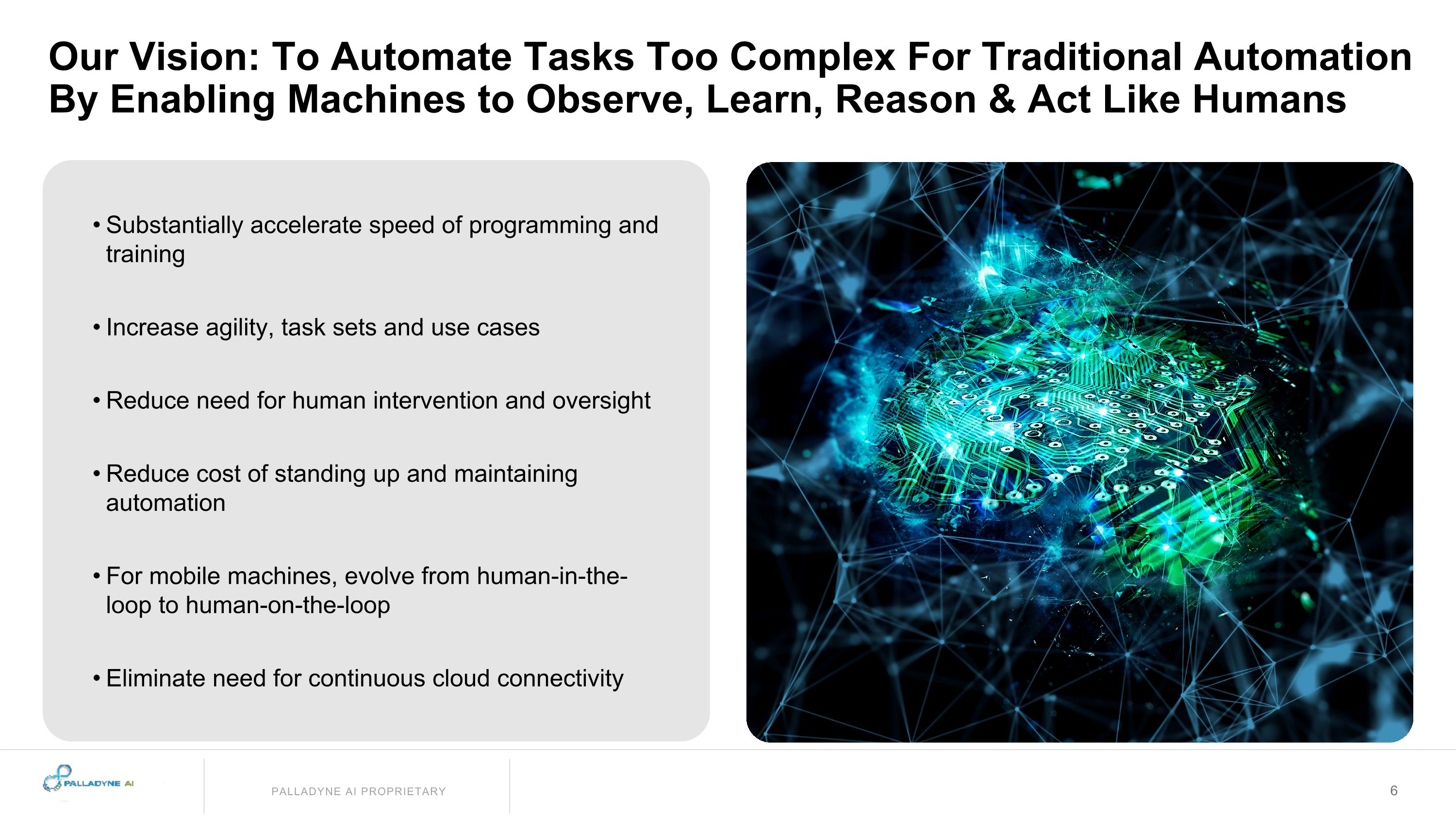
Our Vision: To Automate Tasks Too Complex For Traditional Automation By Enabling Machines to Observe, Learn, Reason & Act Like Humans Substantially accelerate speed of programming and training Increase agility, task sets and use cases Reduce need for human intervention and oversight Reduce cost of standing up and maintaining automation For mobile machines, evolve from human-in-the-loop to human-on-the-loop Eliminate need for continuous cloud connectivity
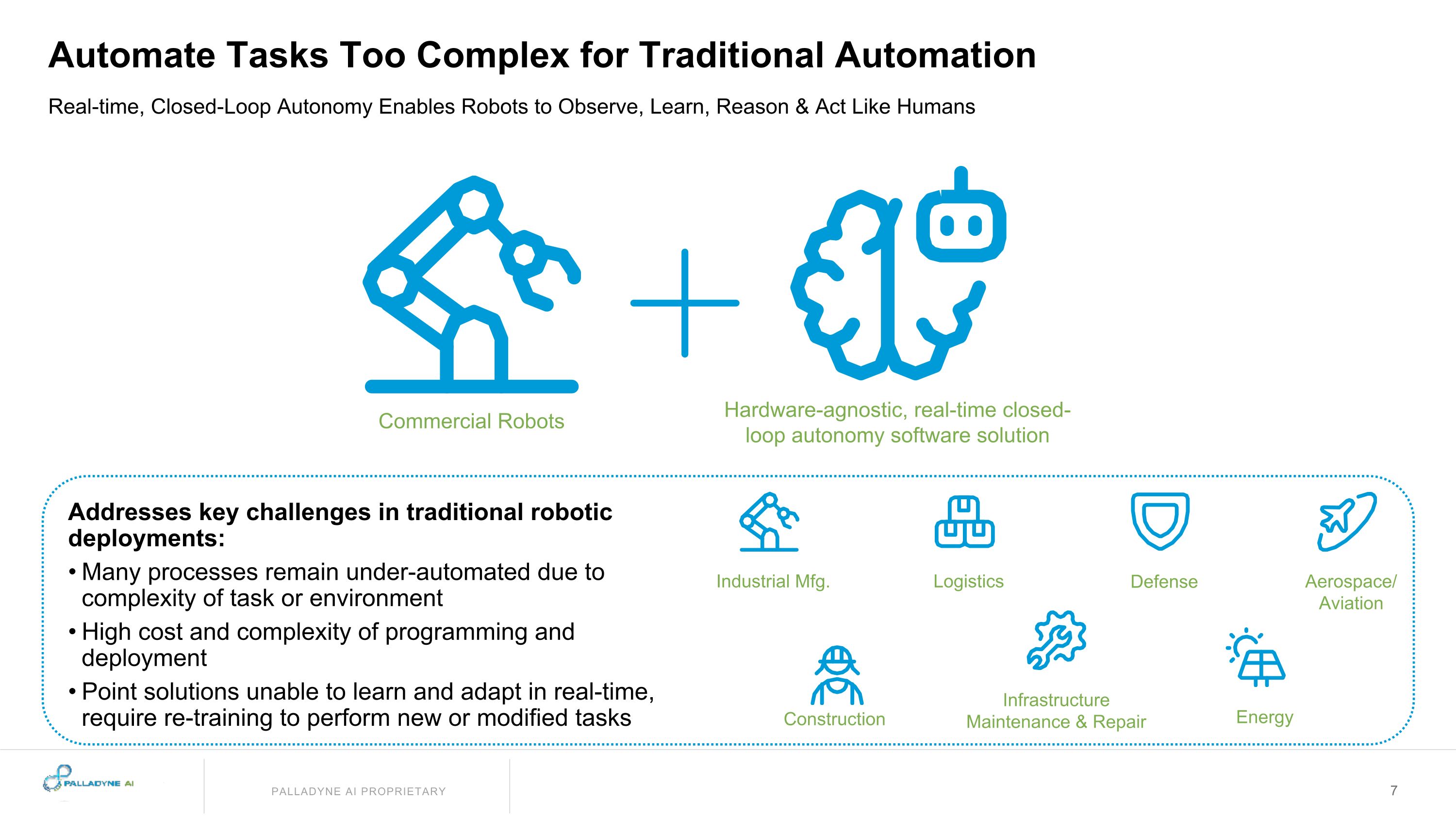
Automate Tasks Too Complex for Traditional Automation Real-time, Closed-Loop Autonomy Enables Robots to Observe, Learn, Reason & Act Like Humans Addresses key challenges in traditional robotic deployments: Many processes remain under-automated due to complexity of task or environment High cost and complexity of programming and deployment Point solutions unable to learn and adapt in real-time, require re-training to perform new or modified tasks Commercial Robots Hardware-agnostic, real-time closed-loop autonomy software solution Industrial Mfg. Logistics Defense Aerospace/ Aviation Construction Infrastructure Maintenance & Repair Energy
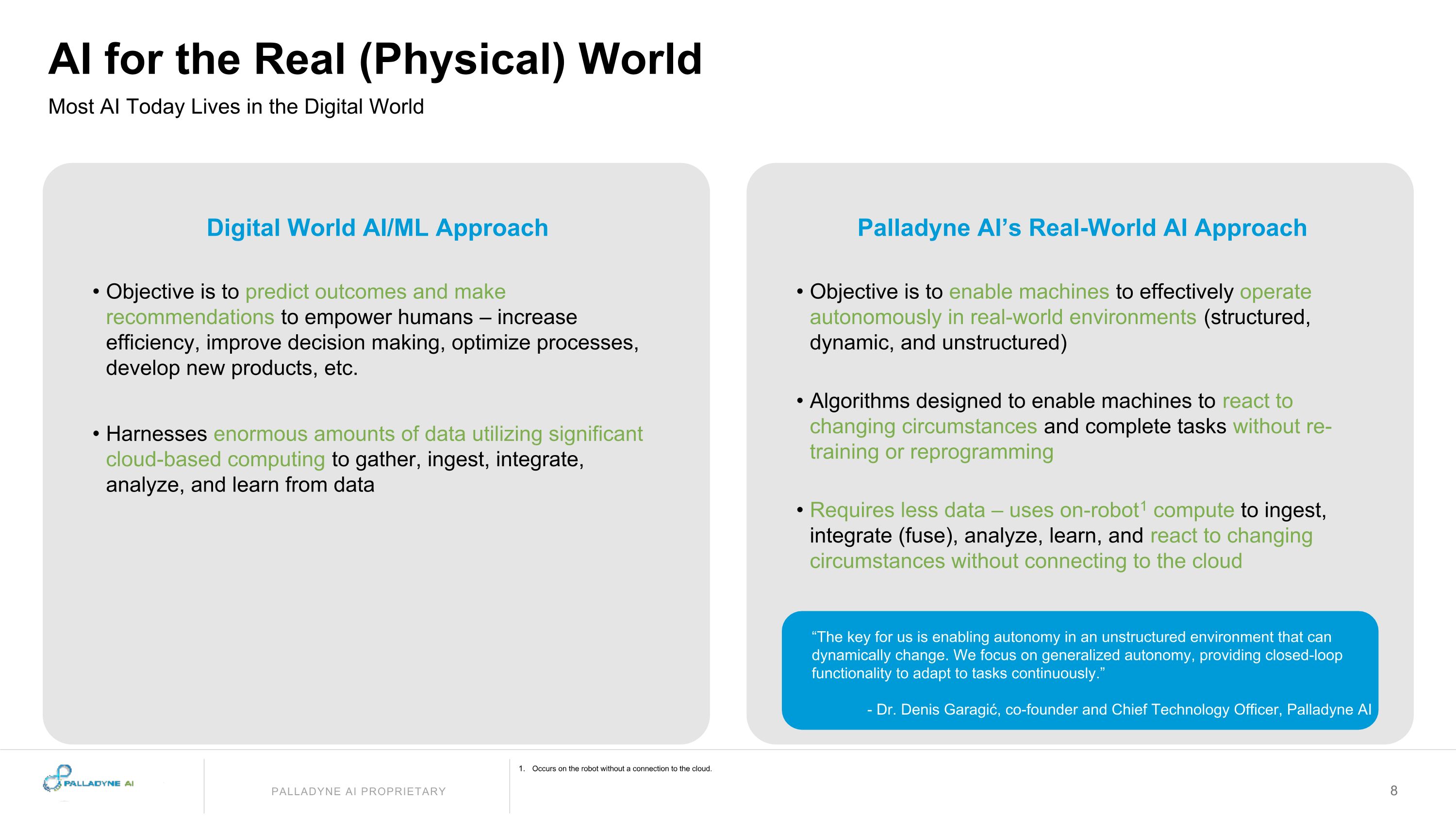
AI for the Real (Physical) World Most AI Today Lives in the Digital World Digital World AI/ML Approach Objective is to predict outcomes and make recommendations to empower humans – increase efficiency, improve decision making, optimize processes, develop new products, etc. Harnesses enormous amounts of data utilizing significant cloud-based computing to gather, ingest, integrate, analyze, and learn from data Palladyne AI’s Real-World AI Approach Objective is to enable machines to effectively operate autonomously in real-world environments (structured, dynamic, and unstructured) Algorithms designed to enable machines to react to changing circumstances and complete tasks without re-training or reprogramming Requires less data – uses on-robot1 compute to ingest, integrate (fuse), analyze, learn, and react to changing circumstances without connecting to the cloud Occurs on the robot without a connection to the cloud. “The key for us is enabling autonomy in an unstructured environment that can dynamically change. We focus on generalized autonomy, providing closed-loop functionality to adapt to tasks continuously.” - Dr. Denis Garagić, co-founder and Chief Technology Officer, Palladyne AI

Palladyne™ IQ: AI Software Platform for Robotics Real-Time Closed-Loop Autonomy Framework Designed to Enable Machines to Observe, Learn, Reason, and Act Like Humans Act Precise Robotic Control & Completion of Tasks Completes the task by accurately controlling the manipulator arm, robot, and/or end effector Achieves complex combination of tasks over extended periods of time in a stable, safe, and precise manner Reason Human-like, AI-based Reasoning to Determine Best Course of Action Without Human Intervention Enables robots to adapt to unexpected events in real-time Generates real-time motion plans based on situational awareness at the edge Real-time perceiving, learning & decision-making occurs at the edge without retraining or cloud connectivity Observe Advanced Perception & Observation to Improve Situational Awareness Perceives environment using a mix of sensor inputs, e.g., vision, LiDAR, radar, acoustic, etc. Utilizes Multi-Modal Sensor Fusion to make perception more robust to sensor occlusion and noise Learn Intelligent Machine Learning to Accelerate Onboarding for New & Complex Tasks Robots learn novel or complex combination of tasks via dynamic reasoning and learning Learning occurs with minimal demonstrations (1-5)1 Learning model adapts to environments Based on internal testing, actual figures will vary depending on complexity of the task.
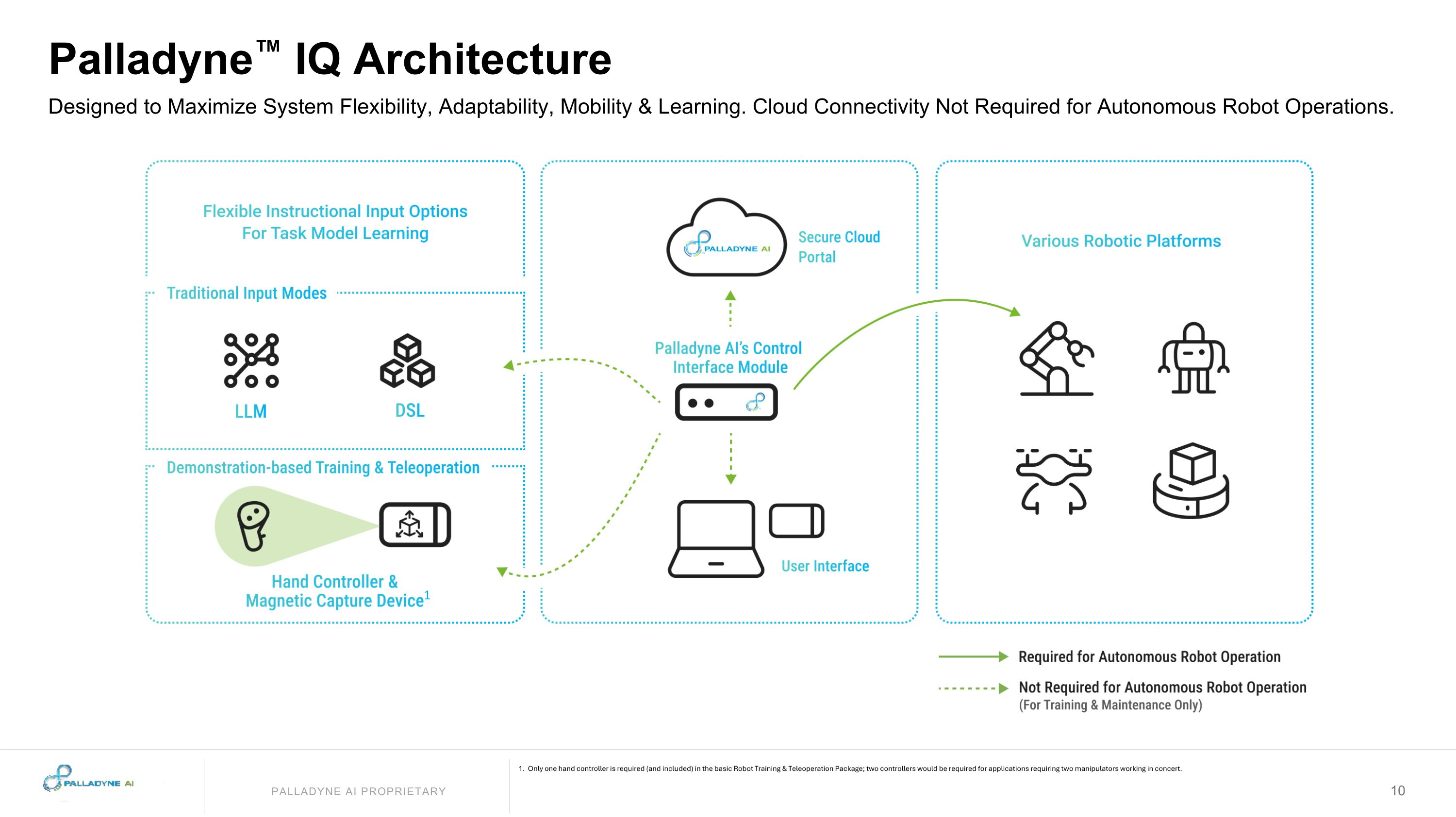
Palladyne™ IQ Architecture Designed to Maximize System Flexibility, Adaptability, Mobility & Learning. Cloud Connectivity Not Required for Autonomous Robot Operations. 1. Only one hand controller is required (and included) in the basic Robot Training & Teleoperation Package; two controllers would be required for applications requiring two manipulators working in concert. 1
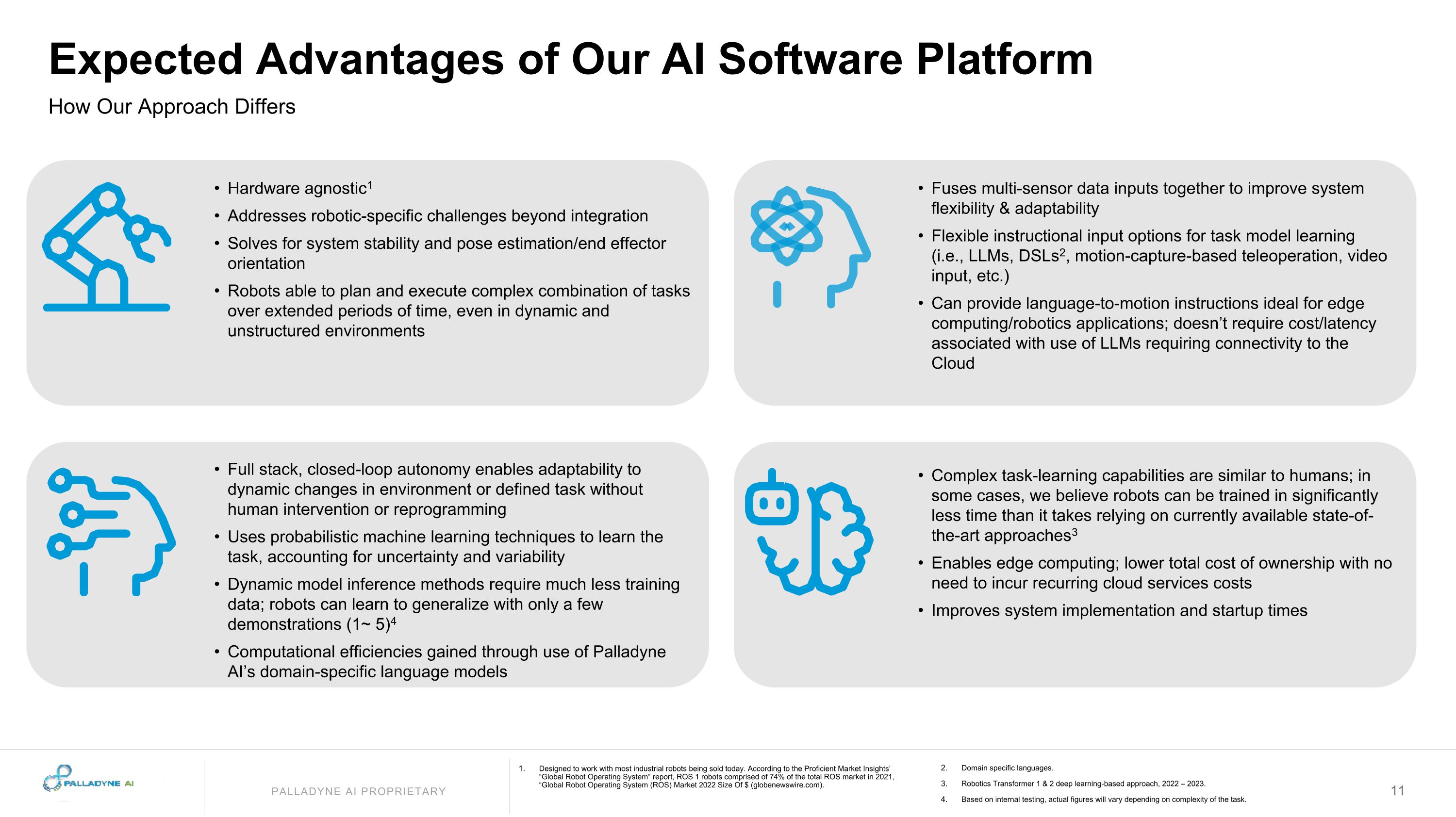
Expected Advantages of Our AI Software Platform How Our Approach Differs Hardware agnostic1 Addresses robotic-specific challenges beyond integration Solves for system stability and pose estimation/end effector orientation Robots able to plan and execute complex combination of tasks over extended periods of time, even in dynamic and unstructured environments Designed to work with most industrial robots being sold today. According to the Proficient Market Insights’ “Global Robot Operating System” report, ROS 1 robots comprised of 74% of the total ROS market in 2021, “Global Robot Operating System (ROS) Market 2022 Size Of $ (globenewswire.com). Full stack, closed-loop autonomy enables adaptability to dynamic changes in environment or defined task without human intervention or reprogramming Uses probabilistic machine learning techniques to learn the task, accounting for uncertainty and variability Dynamic model inference methods require much less training data; robots can learn to generalize with only a few demonstrations (1~ 5)4 Computational efficiencies gained through use of Palladyne AI’s domain-specific language models Complex task-learning capabilities are similar to humans; in some cases, we believe robots can be trained in significantly less time than it takes relying on currently available state-of-the-art approaches3 Enables edge computing; lower total cost of ownership with no need to incur recurring cloud services costs Improves system implementation and startup times Fuses multi-sensor data inputs together to improve system flexibility & adaptability Flexible instructional input options for task model learning (i.e., LLMs, DSLs2, motion-capture-based teleoperation, video input, etc.) Can provide language-to-motion instructions ideal for edge computing/robotics applications; doesn’t require cost/latency associated with use of LLMs requiring connectivity to the Cloud Domain specific languages. Robotics Transformer 1 & 2 deep learning-based approach, 2022 – 2023. Based on internal testing, actual figures will vary depending on complexity of the task.
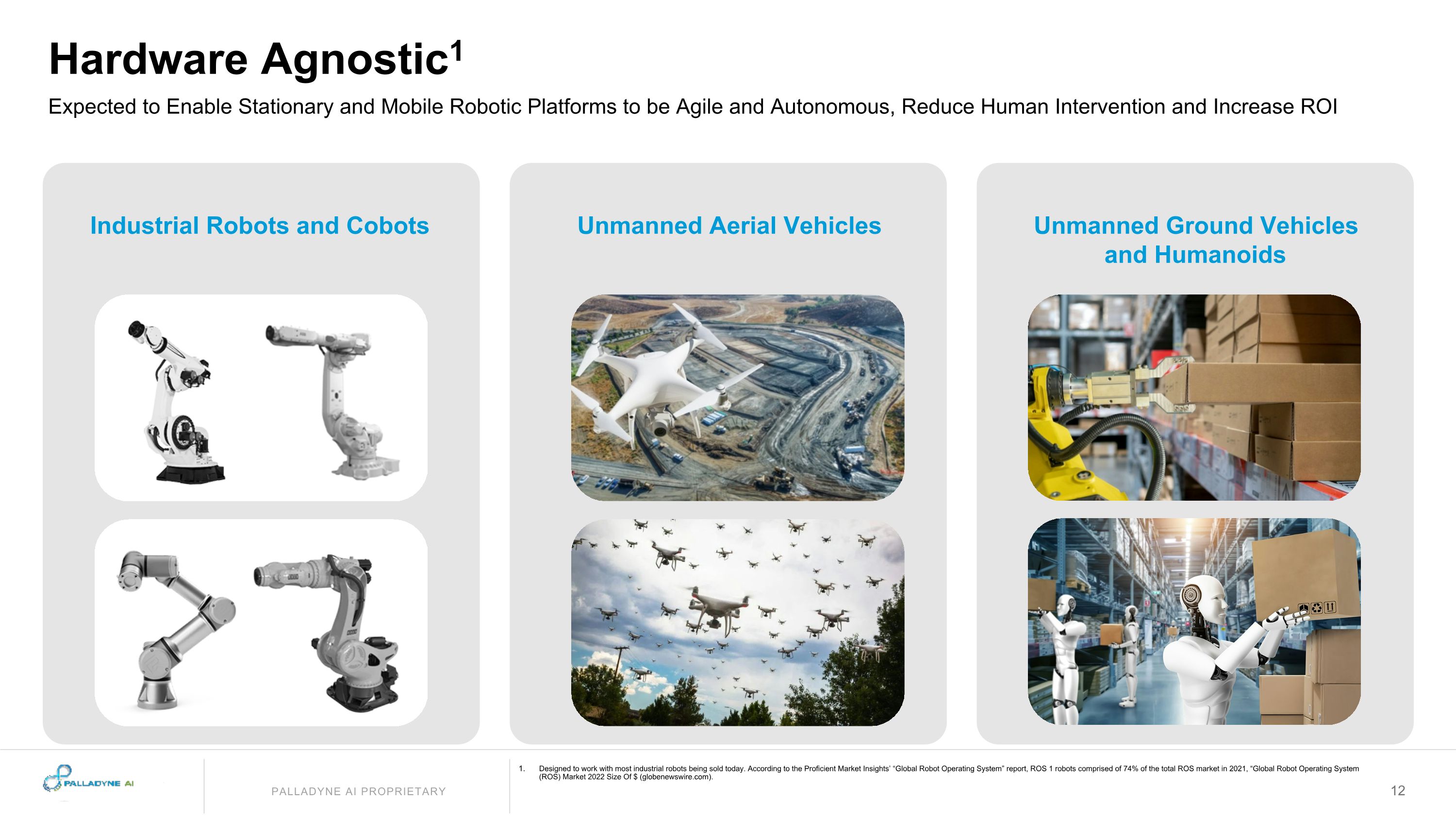
Hardware Agnostic1 Expected to Enable Stationary and Mobile Robotic Platforms to be Agile and Autonomous, Reduce Human Intervention and Increase ROI Designed to work with most industrial robots being sold today. According to the Proficient Market Insights’ “Global Robot Operating System” report, ROS 1 robots comprised of 74% of the total ROS market in 2021, “Global Robot Operating System (ROS) Market 2022 Size Of $ (globenewswire.com). Industrial Robots and Cobots Unmanned Ground Vehicles and Humanoids Unmanned Aerial Vehicles
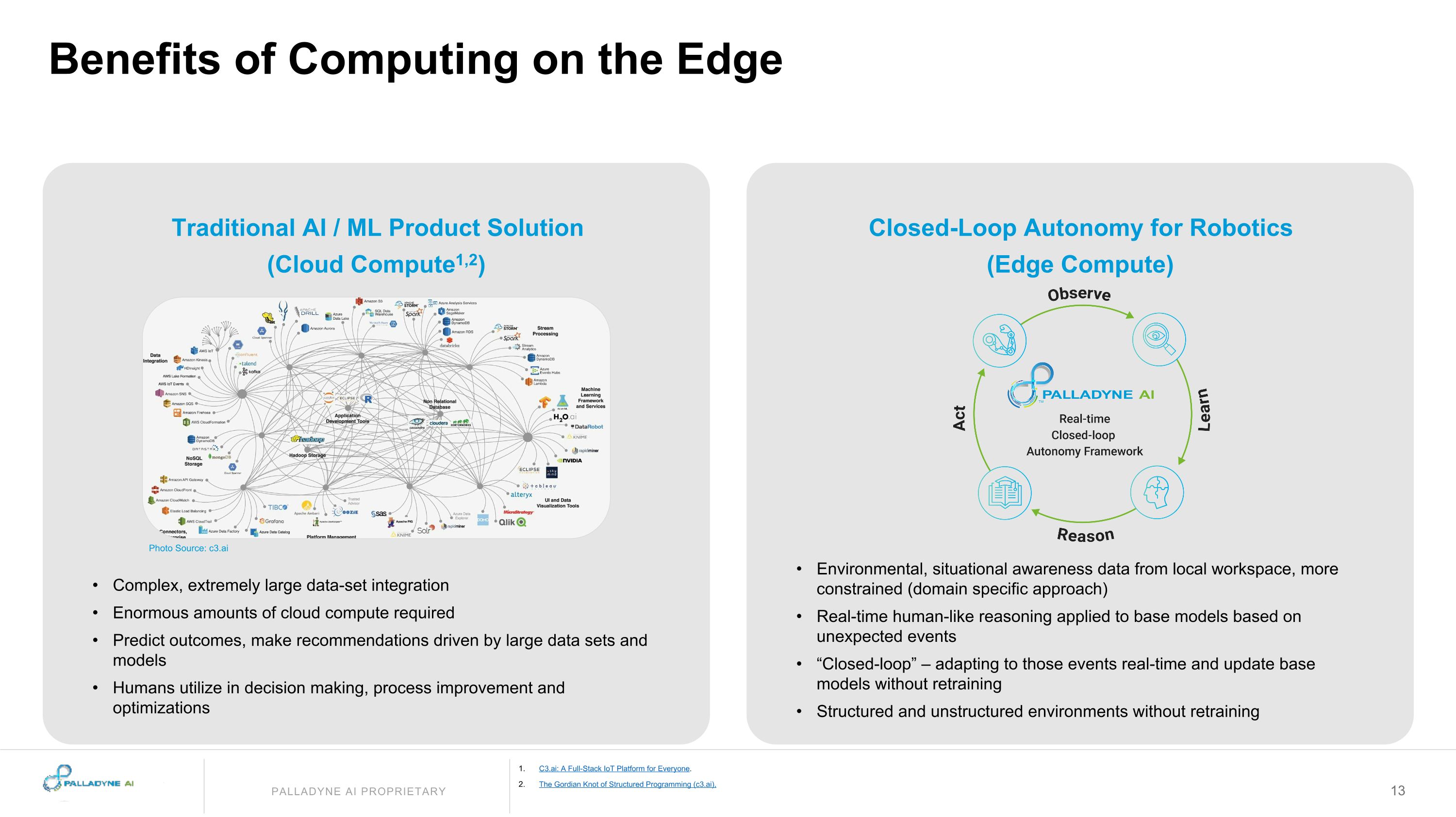
Benefits of Computing on the Edge C3.ai: A Full-Stack IoT Platform for Everyone. The Gordian Knot of Structured Programming (c3.ai), Traditional AI / ML Product Solution (Cloud Compute1,2) Complex, extremely large data-set integration Enormous amounts of cloud compute required Predict outcomes, make recommendations driven by large data sets and models Humans utilize in decision making, process improvement and optimizations Closed-Loop Autonomy for Robotics (Edge Compute) Environmental, situational awareness data from local workspace, more constrained (domain specific approach) Real-time human-like reasoning applied to base models based on unexpected events “Closed-loop” – adapting to those events real-time and update base models without retraining Structured and unstructured environments without retraining Photo Source: c3.ai
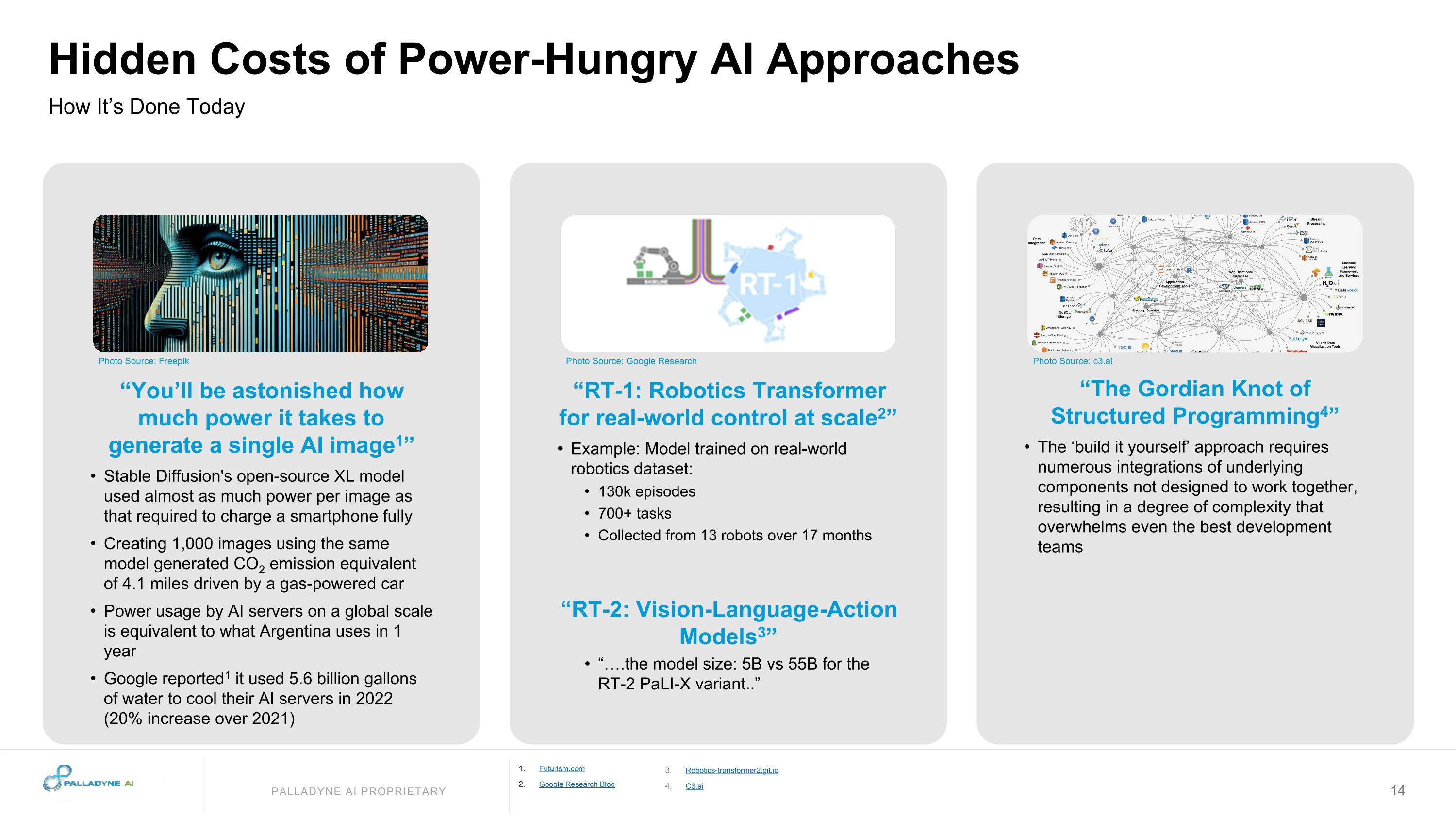
Hidden Costs of Power-Hungry AI Approaches How It’s Done Today “You’ll be astonished how much power it takes to generate a single AI image1” Stable Diffusion's open-source XL model used almost as much power per image as that required to charge a smartphone fully Creating 1,000 images using the same model generated CO2 emission equivalent of 4.1 miles driven by a gas-powered car Power usage by AI servers on a global scale is equivalent to what Argentina uses in 1 year Google reported1 it used 5.6 billion gallons of water to cool their AI servers in 2022 (20% increase over 2021) “The Gordian Knot of Structured Programming4” The ‘build it yourself’ approach requires numerous integrations of underlying components not designed to work together, resulting in a degree of complexity that overwhelms even the best development teams “RT-1: Robotics Transformer for real-world control at scale2” Example: Model trained on real-world robotics dataset: 130k episodes 700+ tasks Collected from 13 robots over 17 months “RT-2: Vision-Language-Action Models3” “….the model size: 5B vs 55B for the RT-2 PaLI-X variant..” Futurism.com Google Research Blog Robotics-transformer2.git.io C3.ai Photo Source: Freepik Photo Source: Google Research Photo Source: c3.ai
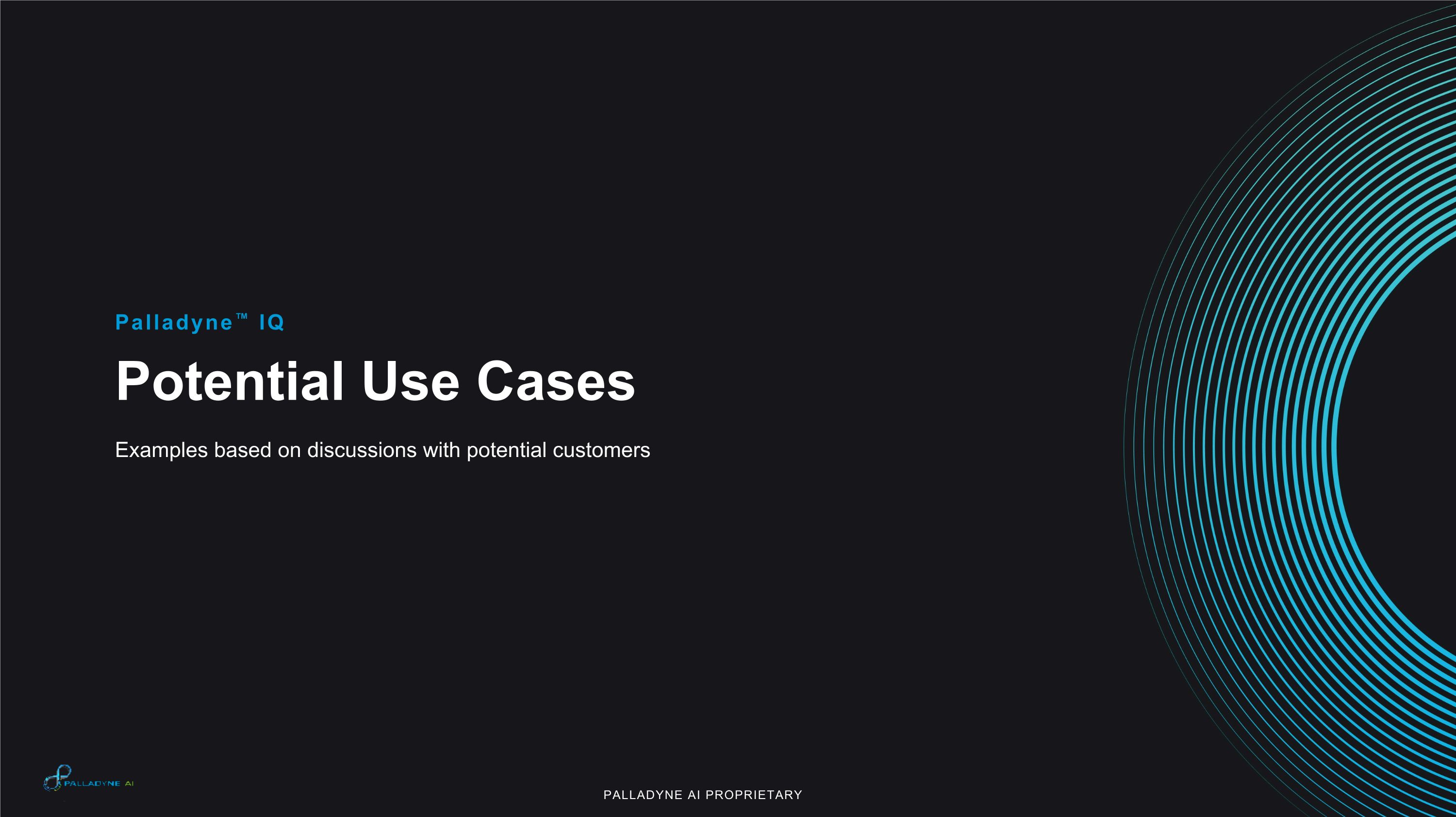
Potential Use Cases Examples based on discussions with potential customers Palladyne™ IQ
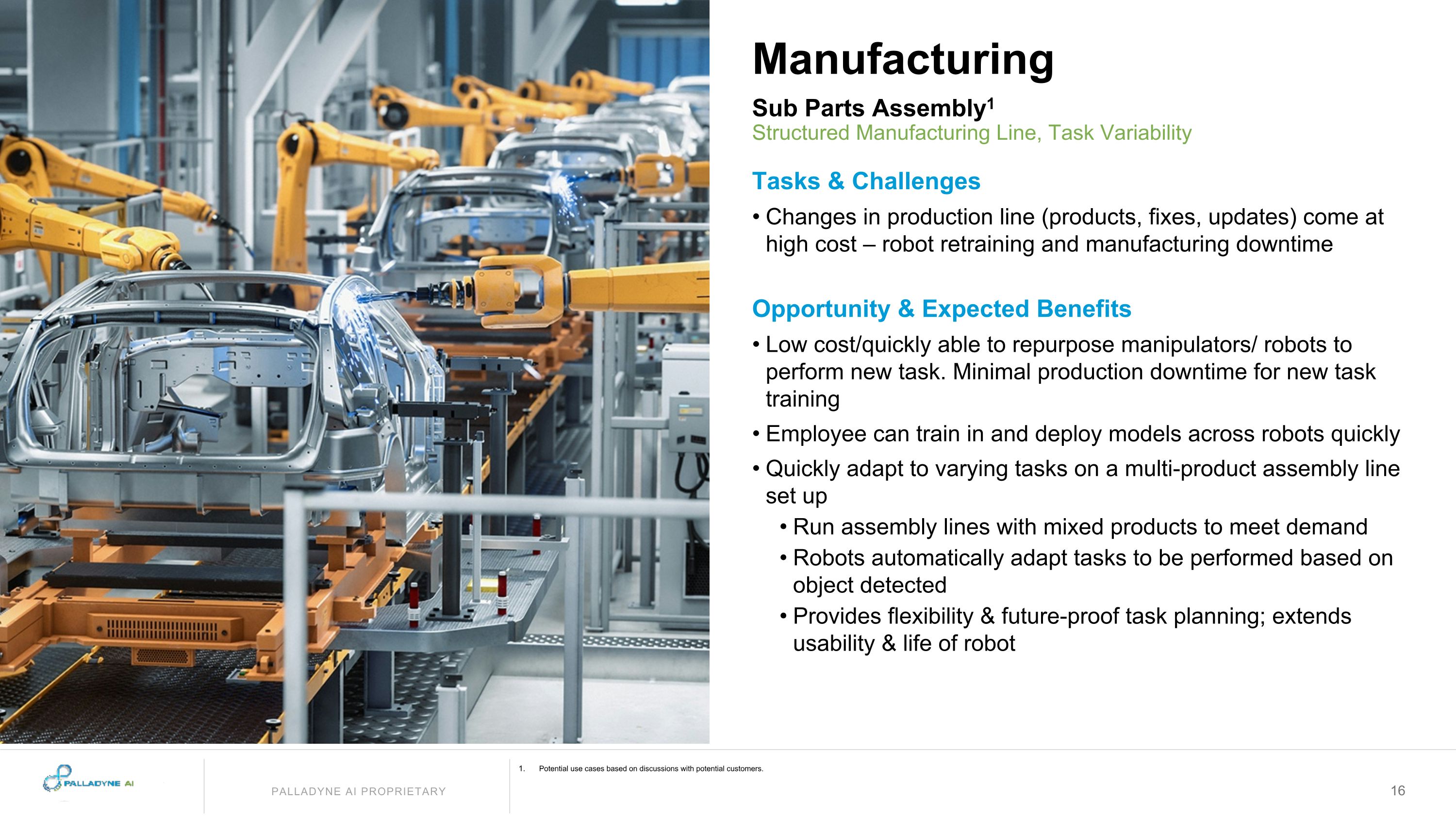
Manufacturing Sub Parts Assembly1 Structured Manufacturing Line, Task Variability Tasks & Challenges Changes in production line (products, fixes, updates) come at high cost – robot retraining and manufacturing downtime Opportunity & Expected Benefits Low cost/quickly able to repurpose manipulators/ robots to perform new task. Minimal production downtime for new task training Employee can train in and deploy models across robots quickly Quickly adapt to varying tasks on a multi-product assembly line set up Run assembly lines with mixed products to meet demand Robots automatically adapt tasks to be performed based on object detected Provides flexibility & future-proof task planning; extends usability & life of robot Potential use cases based on discussions with potential customers.
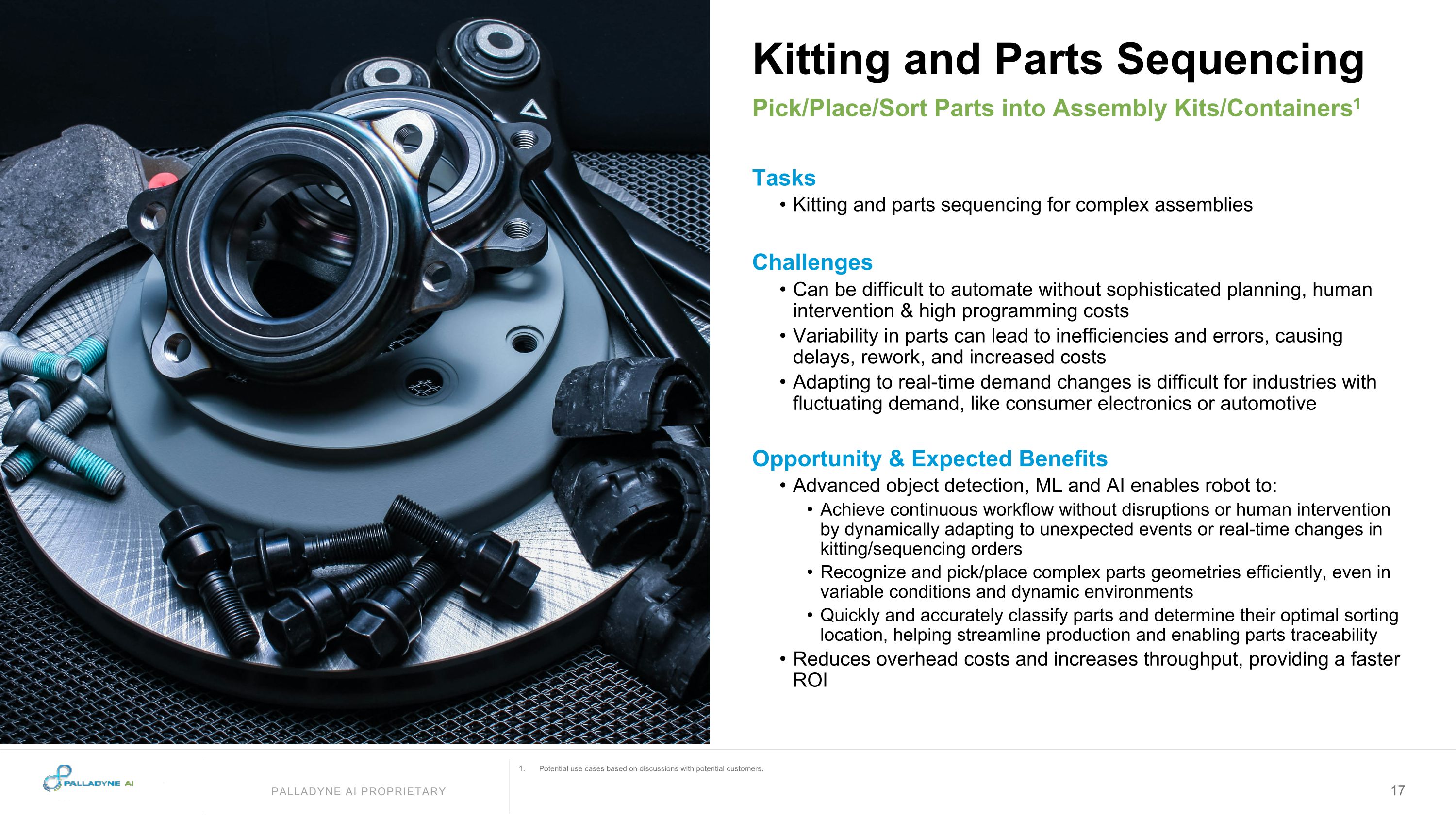
Kitting and Parts Sequencing Pick/Place/Sort Parts into Assembly Kits/Containers1 Tasks Kitting and parts sequencing for complex assemblies Challenges Can be difficult to automate without sophisticated planning, human intervention & high programming costs Variability in parts can lead to inefficiencies and errors, causing delays, rework, and increased costs Adapting to real-time demand changes is difficult for industries with fluctuating demand, like consumer electronics or automotive Opportunity & Expected Benefits Advanced object detection, ML and AI enables robot to: Achieve continuous workflow without disruptions or human intervention by dynamically adapting to unexpected events or real-time changes in kitting/sequencing orders Recognize and pick/place complex parts geometries efficiently, even in variable conditions and dynamic environments Quickly and accurately classify parts and determine their optimal sorting location, helping streamline production and enabling parts traceability Reduces overhead costs and increases throughput, providing a faster ROI Potential use cases based on discussions with potential customers.
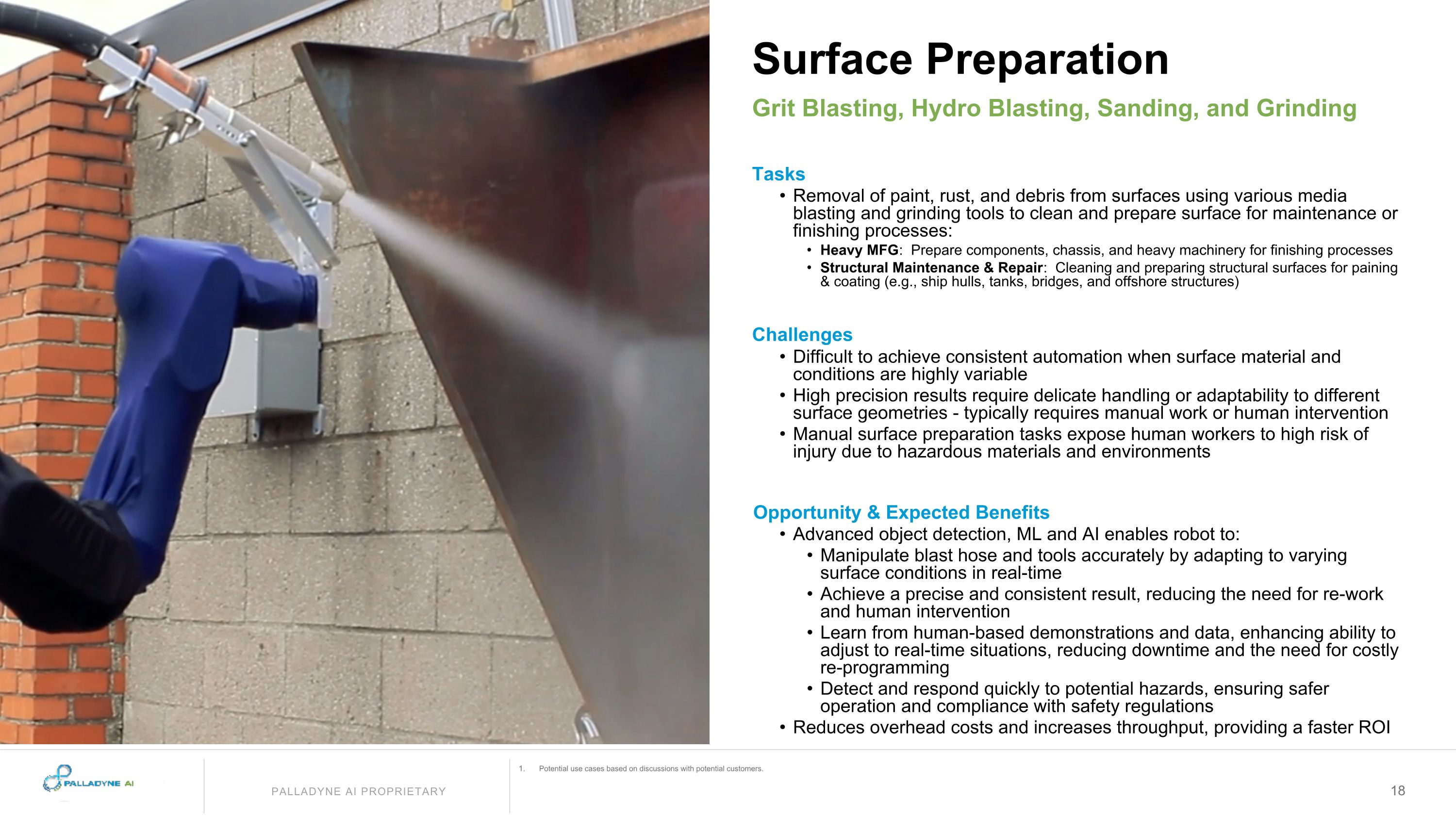
Surface Preparation Grit Blasting, Hydro Blasting, Sanding, and Grinding Tasks Removal of paint, rust, and debris from surfaces using various media blasting and grinding tools to clean and prepare surface for maintenance or finishing processes: Heavy MFG: Prepare components, chassis, and heavy machinery for finishing processes Structural Maintenance & Repair: Cleaning and preparing structural surfaces for paining & coating (e.g., ship hulls, tanks, bridges, and offshore structures) Challenges Difficult to achieve consistent automation when surface material and conditions are highly variable High precision results require delicate handling or adaptability to different surface geometries - typically requires manual work or human intervention Manual surface preparation tasks expose human workers to high risk of injury due to hazardous materials and environments Opportunity & Expected Benefits Advanced object detection, ML and AI enables robot to: Manipulate blast hose and tools accurately by adapting to varying surface conditions in real-time Achieve a precise and consistent result, reducing the need for re-work and human intervention Learn from human-based demonstrations and data, enhancing ability to adjust to real-time situations, reducing downtime and the need for costly re-programming Detect and respond quickly to potential hazards, ensuring safer operation and compliance with safety regulations Reduces overhead costs and increases throughput, providing a faster ROI Potential use cases based on discussions with potential customers.
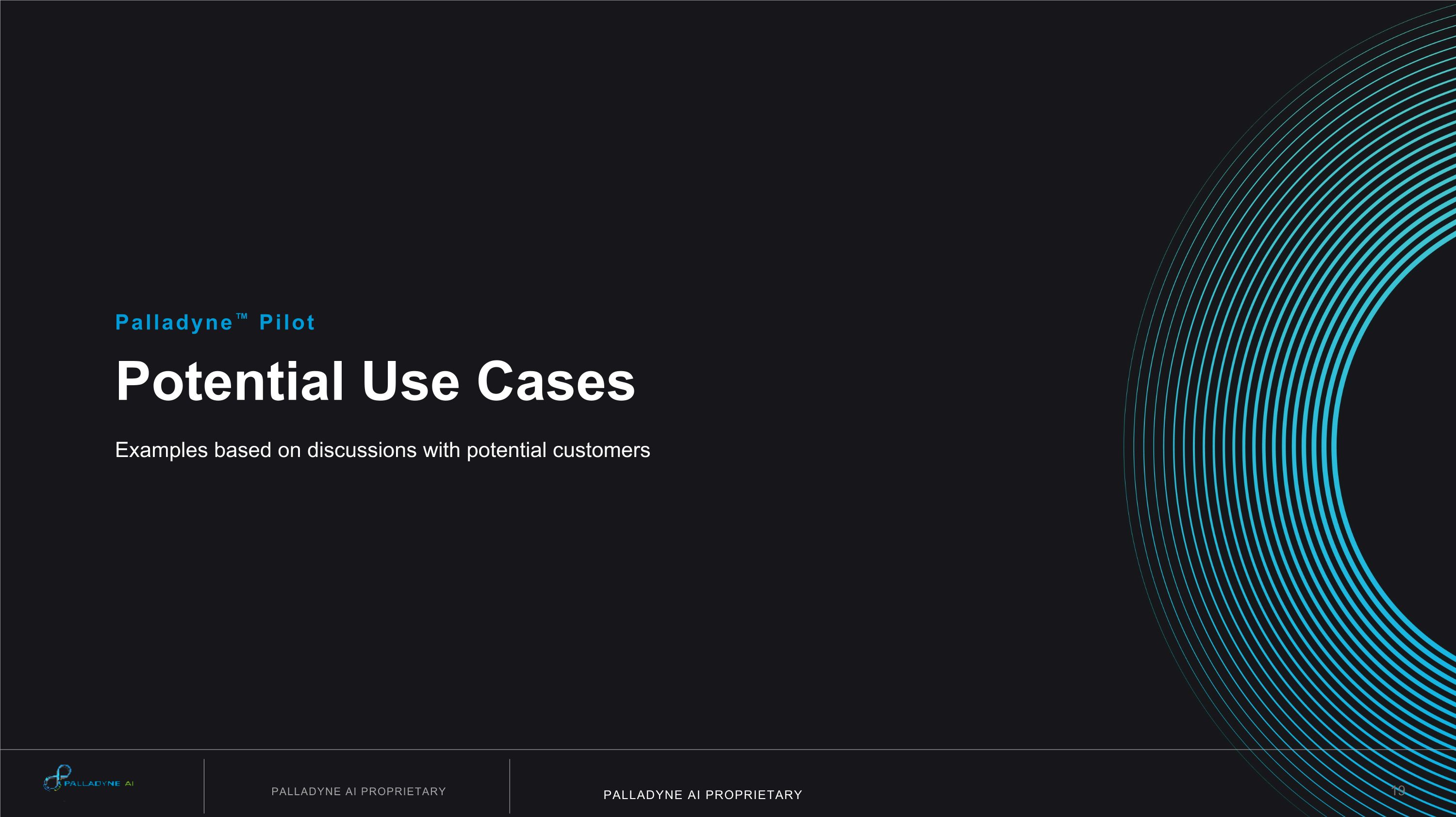
Potential Use Cases Examples based on discussions with potential customers Palladyne™ Pilot
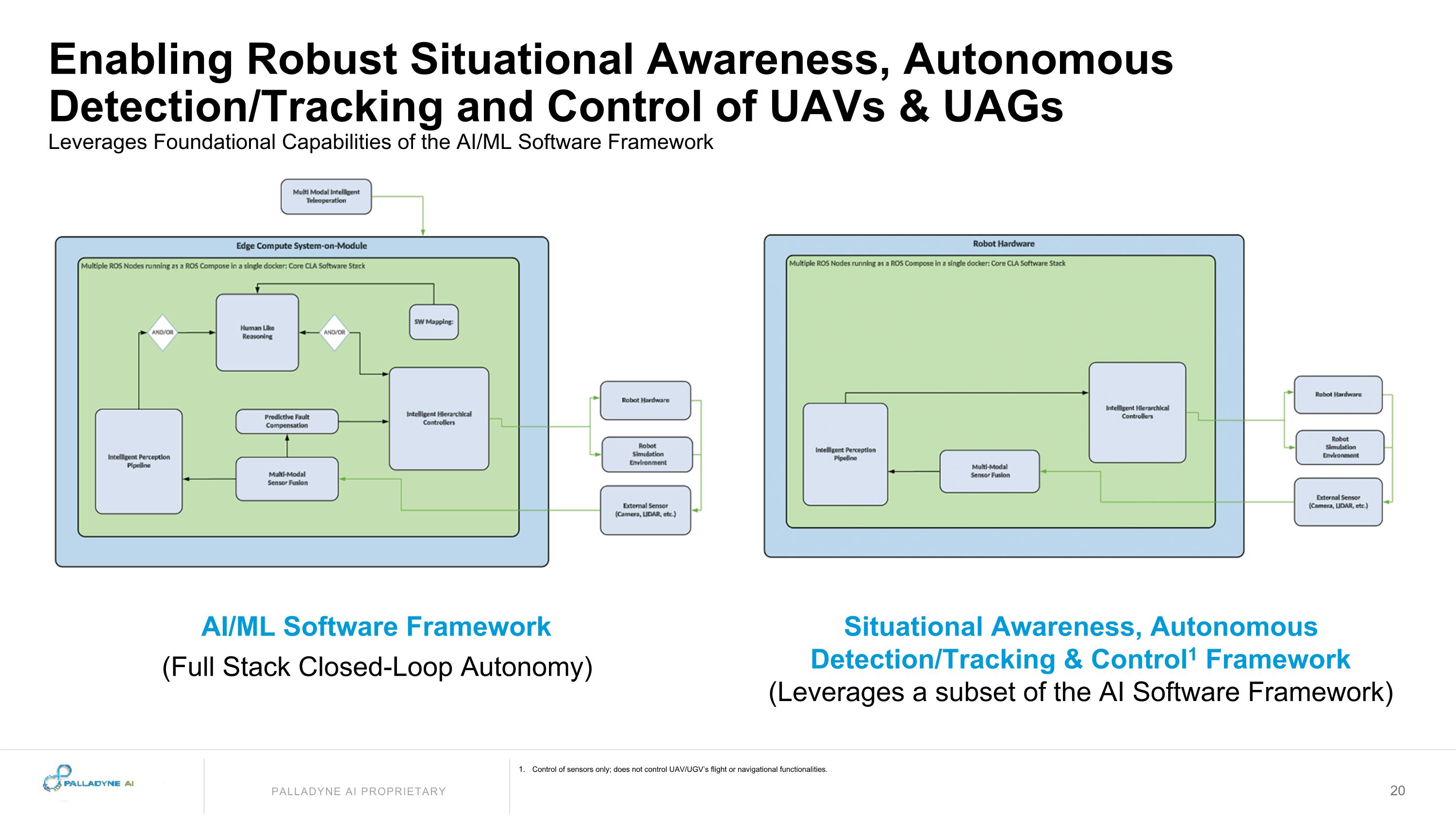
Enabling Robust Situational Awareness, Autonomous Detection/Tracking and Control of UAVs & UAGs AI/ML Software Framework (Full Stack Closed-Loop Autonomy) Situational Awareness, Autonomous Detection/Tracking & Control1 Framework (Leverages a subset of the AI Software Framework) Control of sensors only; does not control UAV/UGV’s flight or navigational functionalities. Leverages Foundational Capabilities of the AI/ML Software Framework
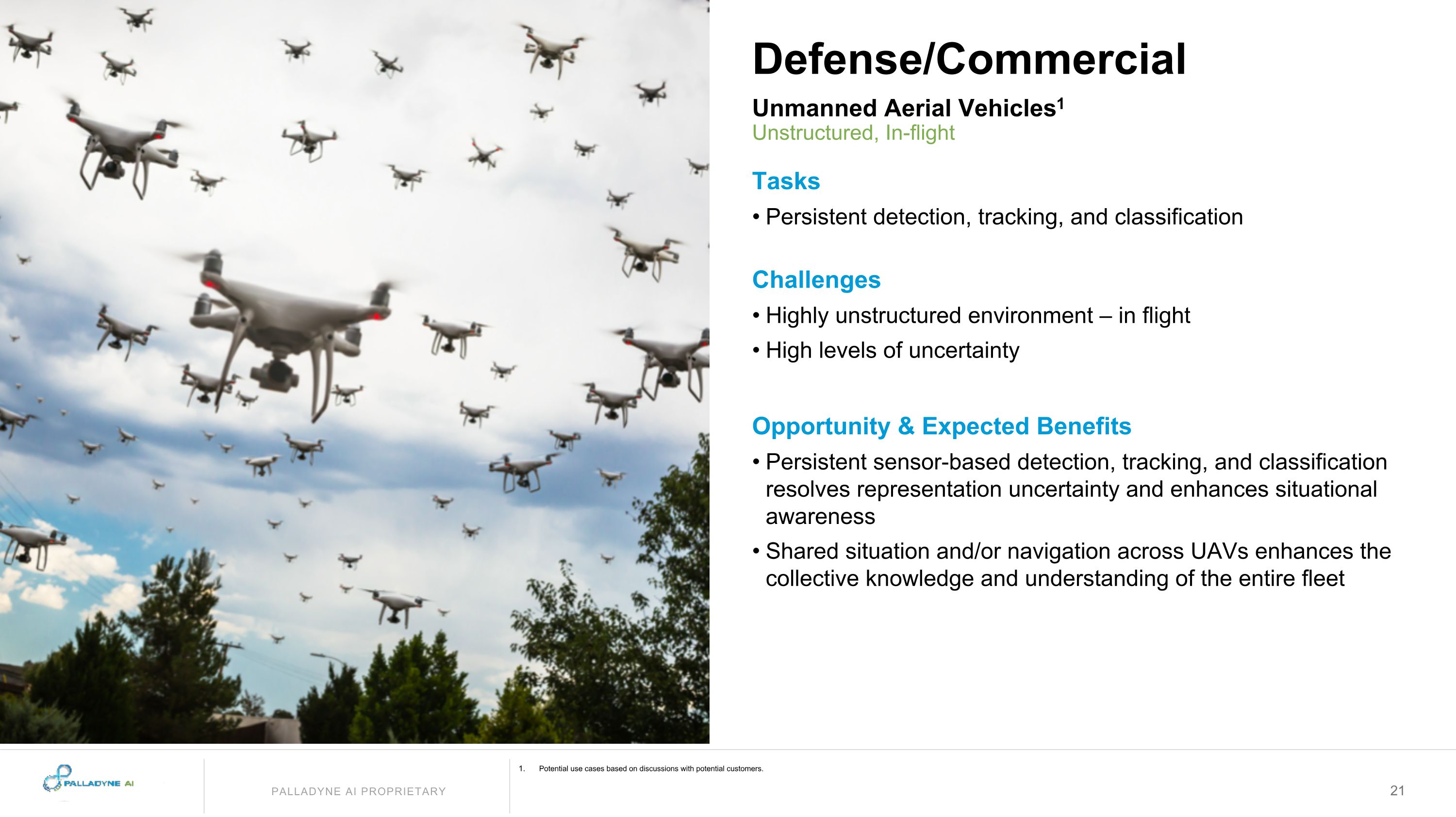
Defense/Commercial Unmanned Aerial Vehicles1 Unstructured, In-flight Tasks Persistent detection, tracking, and classification Challenges Highly unstructured environment – in flight High levels of uncertainty Opportunity & Expected Benefits Persistent sensor-based detection, tracking, and classification resolves representation uncertainty and enhances situational awareness Shared situation and/or navigation across UAVs enhances the collective knowledge and understanding of the entire fleet Potential use cases based on discussions with potential customers.
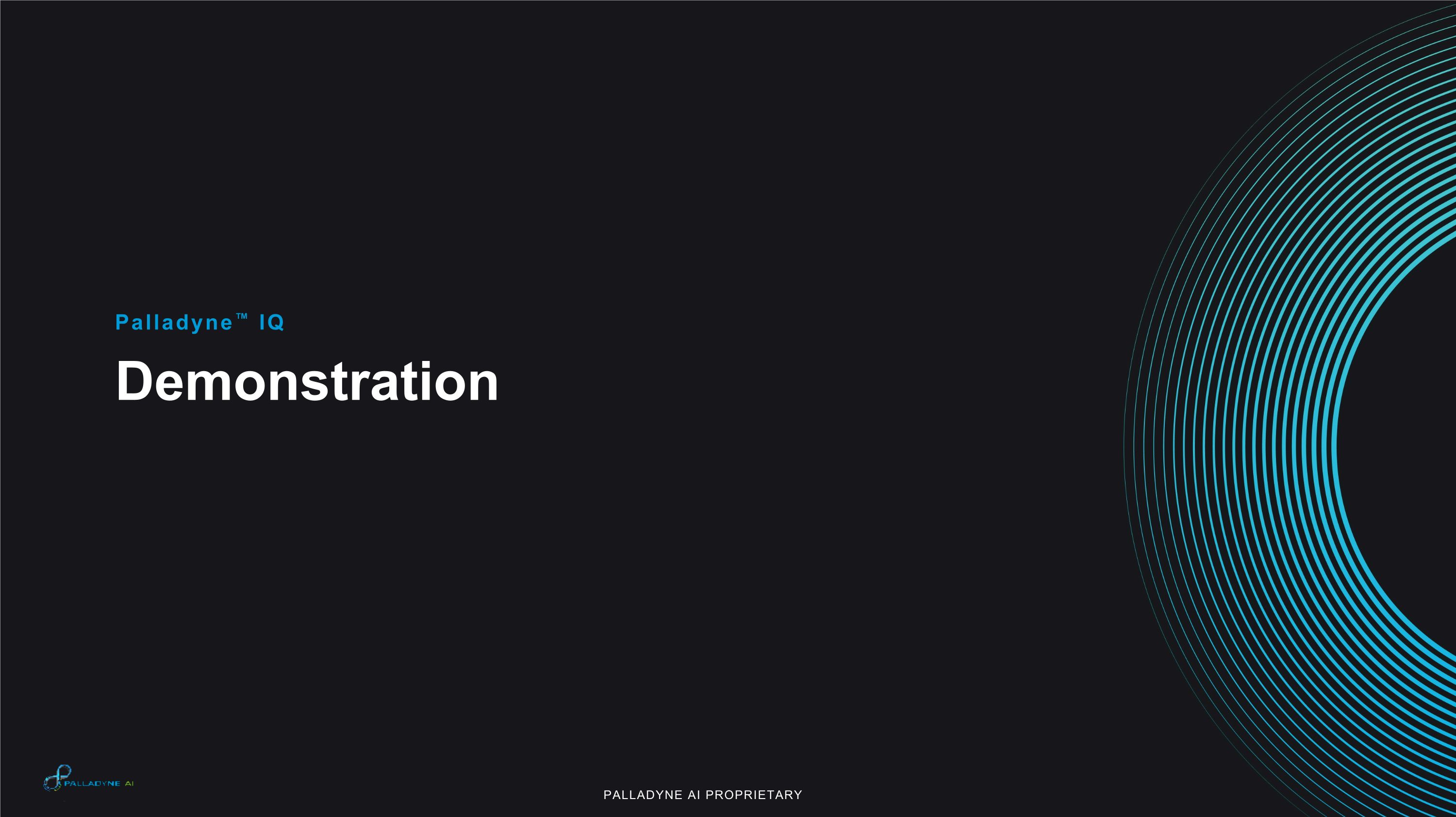
Demonstration Palladyne™ IQ
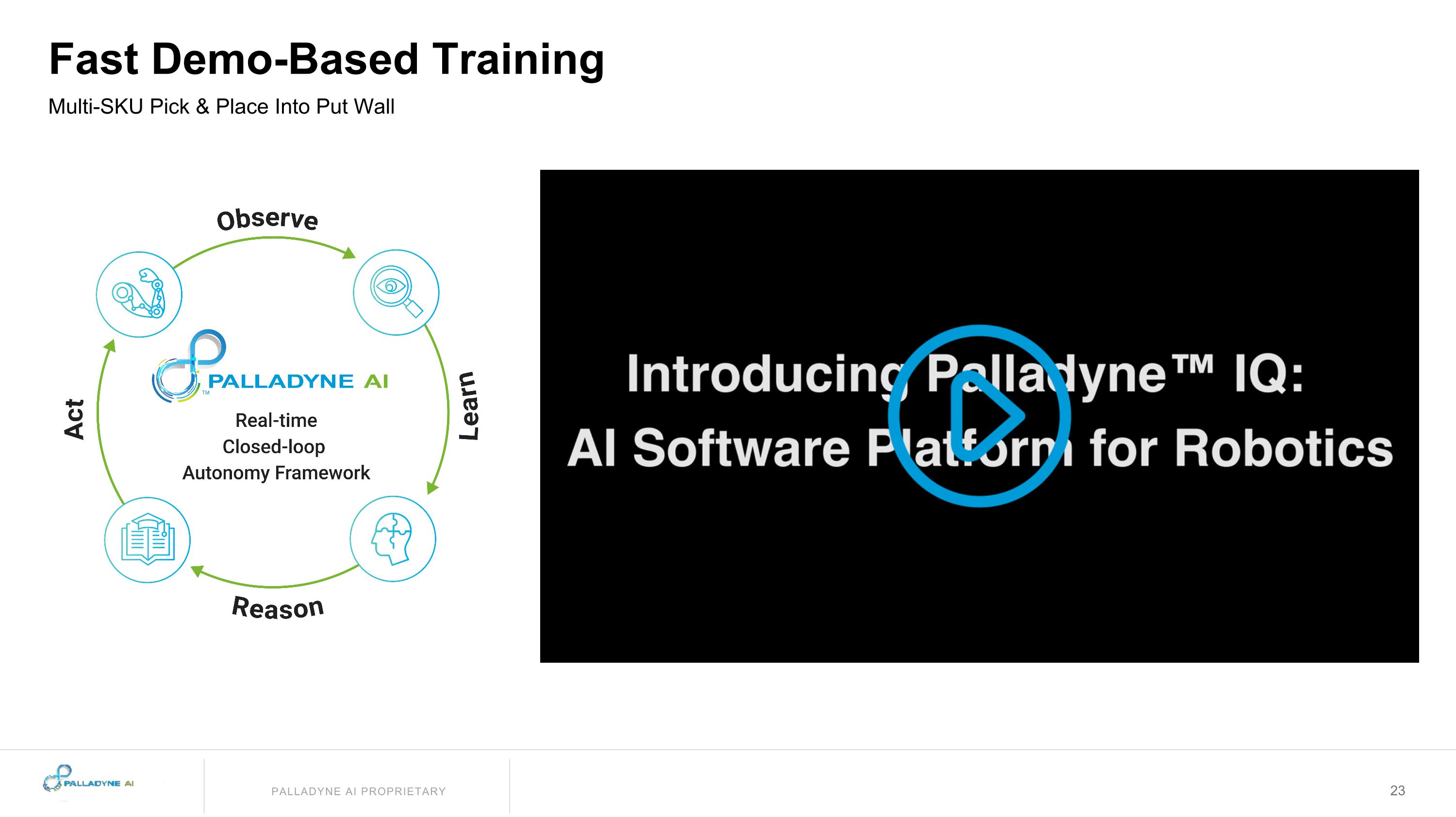
Fast Demo-Based Training Multi-SKU Pick & Place Into Put Wall
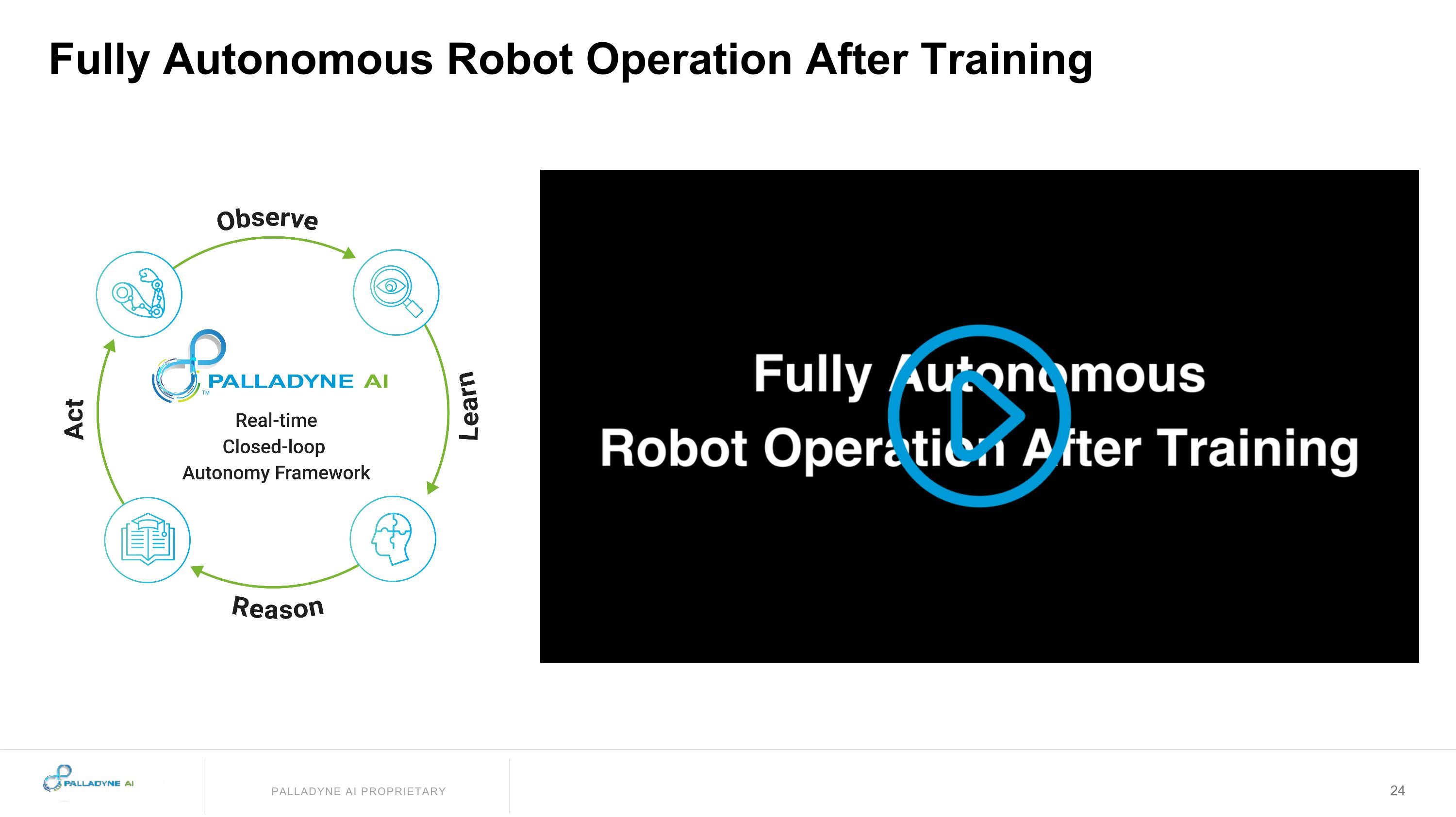
Fully Autonomous Robot Operation After Training
